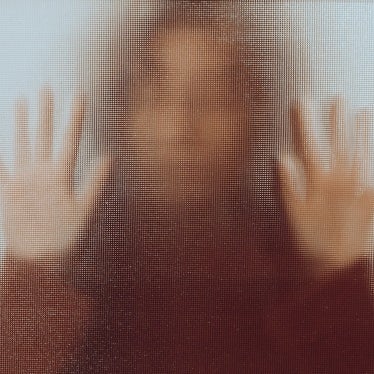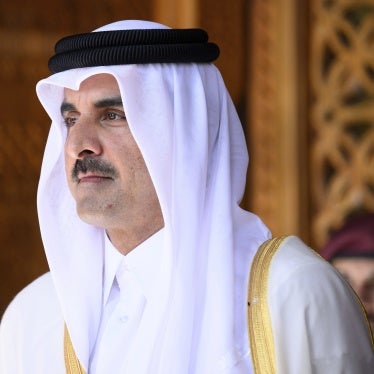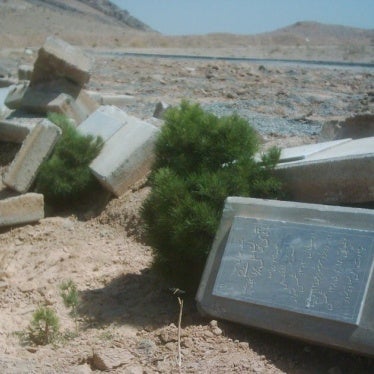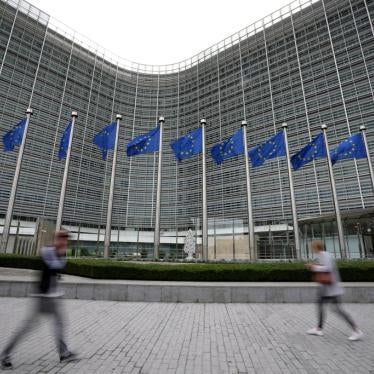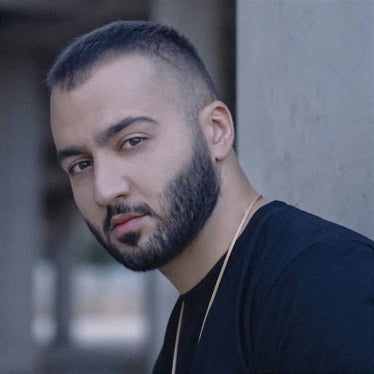(New York) – Both local residents and demonstrators supporting former President Mohamed Morsy died in clashes on the night of July 2, 2013 near Cairo University. The clashes were the deadliest incident of the past week, with 18 people reported dead. Egypt’s transitional authorities should ensure prompt, impartial investigations to determine who was responsible for killings during the political unrest since late June, in which at least 32 people have died.
In the clash near Cairo University, the dead included both local residents and Morsy supporters. Based on visits to hospitals and a morgue and interviews with 15 witnesses, Human Rights Watch identified 11 of the dead, including at least 4 residents of the area and at least 3 participants in a rally and march to support Morsy.
“The deaths on the streets of Egypt over the past several days cry out for an impartial investigation,” said Joe Stork, deputy Middle East and North Africa director at Human Rights Watch. “The available information indicates that both supporters and opponents of Morsy – and possibly security forces as well – were responsible for needless loss of life.”
Human Rights Watch spoke with six of the people injured in the clashes as well as other witnesses. Supporters of Morsy said that civilians – whom they could not identify but described as “thugs”, or baltagiya – and security forces were responsible for some killings. Residents of the area said that Brotherhood supporters attacked them, and shot and injured a police officer.
Witnesses interviewed by Human Rights Watch agreed that police were at the scene briefly but did not intervene to stop the bloodshed. Residents of Bein al-Sarayat, the area where the clashes took place, said they called the police and the army, but, as one put it, “No one came.”
The newspaper Al Masry al Youm reported that Health Minister Mohamed Mostafa Hamed said on July 3 that 18 people had died in the violence near the university during the previous night, and that violence across Egypt since June 30 had left 32 people dead.
On the afternoon of July 2, thousands of Muslim Brotherhood supporters gathered in Nahda Square near Cairo University, in the Giza district of Cairo, for a rally on behalf of Morsy’s presidency. Several Morsy supporters told Human Rights Watch they had come under attack by unidentified “thugs” while walking toward the university from the northeast to attend the rally. The Morsy supporters began marching with others on Ahmed Zewail Street, along the university’s northern edge, toward Tharwat Bridge.
At around 5 p.m., fighting broke out between marchers and people in the buildings on the north side of the street. Several local residents told Human Rights Watch that scuffles began when marchers attacked university students holding up anti-Morsy posters. Violence escalated when residents ran to help the students and were attacked by Morsy supporters, the witnesses said. Two residents showed Human Rights Watch large, fresh wounds on their heads that they said were caused by Morsy supporters wielding clubs and wooden and metal sticks.
Both pro- and anti-Morsy witnesses said they heard gunfire beginning at about 6 p.m. Residents who participated in the clashes acknowledged they armed themselves with stones, rocks, and knives, and Morsy supporters acknowledged that some of them carried guns. Morsy supporters said they came under gunfire from people in buildings on the northern side of Ahmed Zewail street, before reaching Tharwat Bridge, and residents of the area said that gunmen on the roof of a university building on the south side of the street as well as Morsy supporters fired on them. Morsy supporters acknowledged detaining, questioning, and severely beating some men they identified as paid “thugs” who had attacked the march on Ahmed Zewail street.
Exchanges of gunfire intensified at around 10 or 10:30 p.m., witnesses said. Human Rights Watch observed repeated bursts of automatic fire, in addition to other gunfire, at around 11:40 p.m., near the intersection of Cairo University Road and Ahmed Zewail Street. An emergency intake doctor at Um al-Masriyeen hospital in Giza told Human Rights Watch that the majority of gunshot victims who arrived there were injured in the upper body. In cases in which the victims had been shot with live ammunition, the angle of the wound indicated that the shooting had come from above – the tops or upper stories of buildings, the doctor said.
Residents who opposed the pro-Morsy demonstration told Human Rights Watch that they phoned repeatedly for police assistance, but that security forces only arrived after midnight. Videos taken by local journalists that Human Rights Watch viewed show armored vehicles in the area at nighttime, but a resident interviewed in one of the videos said she was not aware of a stabilizing police presence until the following morning at 8 a.m. Residents said that Morsy supporters shot a police officer in the face. One Morsy supporter said he saw members of the Central Security Forces arrive and begin firing automatic weapons at around 11:30 p.m., killing a Morsy supporter.
A July 4 statement from the Interior Ministry said it had formed teams to investigate various events over recent days, arrest all suspects regardless of their affiliations or alignments, and enforce the law on all without discrimination.
On several occasions in the past, including the killing of 42 civilians in Port Said, Human Rights Watch has determined that police used greater lethal force than necessary to protect themselves or others from violence, killing civilians. Both the past excessive use of lethal force, and police failure to minimize casualties during the latest round of violence, indicate the continued and pressing need for security sector reform.
Under international human rights standards applicable to Egypt at all times, law enforcement officials need to take all reasonable steps to protect lives, especially when aware of specific threats. But they can only use intentional lethal force when strictly necessary to protect life.
“Accountability for serious crimes by all parties is key if the transitional government is serious about moving toward an inclusive and democratic Egypt,” Stork said. “Investigations into the awful events at Cairo University, in which Morsy supporters apparently were both attackers and victims, will be a crucial test.”
Deadly Violence Near Cairo University
Essam Khalifa, 33, and his brother Mahmoud, 35, from the Haram neighborhood, were shot and injured while participating in the pro-Morsy demonstrations. Essam Khalifa said they were shot when they entered a building on Ahmad Zuweil street to try to disarm people shooting at the march from the roof. Human Rights Watch observed birdshot injures in Essam Khalifa’s chest, upper right arm and elbow, and gunshot and birdshot wounds in Mahmoud Khalifa’s legs and chest. Essam Khalifa told Human Rights Watch that his brother was shot in the left leg with a bullet and in the right leg and chest with birdshot. Essam Khalifa said:
The march started in al-Amraneya at around 3:30 p.m. and reached Cairo University at 4:30 or 5 p.m. We got to Bein al-Sarayat at around 5:30 p.m. Thugs started firing on us at 6 p.m. with shotguns and live bullets, and threw Molotov cocktails, and stones. There were people shooting from the roof of the Faculty of Literature building, and on top of a yellow residential building. At around 8 p.m., Mahmoud and I decided to storm into a residential building where snipers were shooting from. I didn’t have a weapon. Mahmoud grabbed a piece of wood. We confronted a group of people at the entrance and chased them up the stairs. I’m not sure exactly how many but at least five floors. When we reached the top they began to shoot at us, and that’s when we were shot.
Mahmoud Khalifa was recovering from surgery to remove the bullet in his left leg. His brother-in-law, Ayman, later told Human Rights Watch, “The general prosecutor has the bullet now.”
Several Muslim Brotherhood members described seizing men who had attacked the march, and dragging them away in the direction of Nahda Square. A 38-year-old Muslim Brotherhood supporter, who asked not to be identified, told Human Rights Watch:
I was there at around 6 p.m. when they started to shoot. I was injured in the hand and knee from [shotgun] pellets. They were shooting teargas too. We captured three of them and really beat them up. We dragged them off and broke one’s arms.
A 38-year-old Morsy supporter told Human Rights Watch that he had helped “seize” a man he believed was a paid thug at around 9:30 p.m. “We didn’t want to kill him, but we needed to ask him some questions. We held him under the stage [at the rally], we were holding about eight people under the stage.”
Exchanges of gunfire apparently intensified at around 10 or 10:30 p.m. A journalist who lives in the area, Ihab al-Fouli, told Human Rights Watch that later that night, some Morsy supporters shot at the Boulaq police station, “so the police did a special operation, but then a high-ranking officer was injured and later died and the police retreated,” al-Fouli said. A police officer identified by both a witness and Ahram Online, the government outlet, identified as Officer Satea al-Nomani, was shot in the face and seriously injured. Some Morsy supporters alleged that they came under fire from security forces with assault rifles.
Khaled Shawqi, 40, a shop owner, identified two residents of the immediate neighborhood who were killed by gunshots, which he believed were fired by Morsy supporters: Abdel Aziz Ahmed al-Ors and Mohamed Said Yusif. “Abdel Aziz’s family are butchers,” Shawqi said. “He was just trying to protect his cows. He was deaf. His father was injured too – he was shot in the leg.”
In a video interview filmed by an independent Cairo-based media collective, Mosireen, another resident of the area, says that al-Ors was shot in the abdomen and that the same bullet injured his father’s leg. Shawqi, the shop owner, described another victim as a 37-year-old engineer. Shawqi and residents interviewed in the video said the gunfire came from the direction of the Business Administration building in the Cairo University campus, on the south side of Ahmed Zuweil Street. Human Rights Watch observed five bullet holes in the front of Shawqi’s building.
Human Rights Watch observed repeated bursts of automatic gunfire and other gunfire on Ahmed Zuweil Street from around 11:40 to 11:55 p.m. near the corner of Cairo University Road. Several Morsy supporters said the shooting came from a yellow building and a red brick apartment building, both under construction on the north side of the street.
Participants in the pro-Morsy rally helped evacuate some of those wounded to ambulances stationed at Nahda Square. At around 12:15 a.m., Human Rights Watch observed a civilian car drive a man in his 50s who had been shot in the thigh to an ambulance, and spoke with two brothers wounded with birdshot pellets. Abdou, 25, said that men in civilian clothes shot at them from a building close to Tharwat Bridge, hitting him in his left forearm with three pellets. His brother Hani, 27, was hit underneath his left eye with a pellet that lodged in his face.
At Cairo’s Zeinhoum morgue, Human Rights Watch spoke with relatives and neighbors of two men who had been killed while participating in the Muslim Brotherhood rally. As men carried away the coffin of one victim, Ahmed `Abd al-Wahab Hassan, 39, his brother Mohamed, 28, told Human Rights Watch that Hassan was fatally shot shortly after speaking to a crowd at the rally.
“At first they were shooting teargas at us from far away,” Mohamed Hassan said. “And he said to me, ‘Why are you afraid? This won’t turn into another Abbaseyya,’” referring to a deadly clash in Cairo in April, 2012. Then when he went up and spoke to the crowd, they were attacked with Molotovs and live fire.” Hassan was shot in the chest with a live bullet at around 1 a.m., his brother said. Two neighbors said that Hassan, who had two sons and a daughter, was a religion teacher in Cairo’s Shoubra al-Khaima neighborhood.
Another man, Mustafa Amin Gharib, 21, was killed “by a burst of very rapid gunfire,” according to a witness. Islam Said, 23, told Human Rights Watch:
At 11:30 p.m. there was machine gun fire. There were two people shooting from above in an apartment building under construction. Mustafa was pulling away injured people to get them to safety. Then two armored vehicles came from the top of the [Tharwat] bridge, and I saw six police – Central Security Forces – wearing black. First they shot tear gas, then machine guns. Mustafa was hit in his side, his back and his shoulder. He was alive until he reached the [Agouza] hospital.
A video posted on YouTube by MoheetTV shows armored police vehicles on the scene during the clashes. Residents of Bain al-Sarayat, interviewed in another Mosireen video, also said in the video that the police arrived on the scene for 15 minutes to half an hour, at an unspecified time, and took little action, leaving them to fend for themselves.
A Health Ministry employee working with ambulance crews in Nahda Square, in front of Cairo University’s main entrance, told Human Rights Watch that at around 8 p.m. ambulances evacuated 15 people with gunshot wounds to Qasr al-Aini hospital. “I saw one man with eight shotgun pellets in his chest. All the injuries we’ve seen were from shotguns.”
Ambulances took the wounded to Agouza, Um al-Masryeen, Boulaq, and Qasr al-Aini hospitals, hospital staff said. Staff at two hospitals confirmed to Human Rights Watch five gunshot fatalities and two stabbing fatalities.
Dr. Sama Shehata, the assistant director at Agouza hospital, told Human Rights Watch: “The injuries started coming here at 7:30 p.m. and kept coming until 12:30 a.m. We’ve had 54 people injured from the fighting.” As of 1:15 a.m., he said, three victims remained in the hospital, including one man suffering a concussion and another who had been stabbed. Two other men admitted to Agouza had died, Shehata said – a 25-year-old shot in the chest and a 55-year-old shot in the abdomen with live fire.
Dr. Mohamed Sherbini, director of emergency admissions at Um al-Masriyeen hospital, told Human Rights Watch that the hospital received 67 wounded patients, the majority from 7:30 p.m. to 11:30 p.m. on July 2, including three men killed by live ammunition and two who died from stab wounds. Six of the injured were hit by bullets, 49 by birdshot, and 12 were stabbed or beaten with sticks, he said.
Consistent with witness statements that there were gunmen on upper floors of unfinished apartment buildings or on the roof of a university building, the doctor said that most shooting victims treated at Um al-Masyreen “were shot in the upper part of their body – face and head, throat, and upper chest – and from the angles that the bullets entered and the fact that they were mostly hit in the upper part of their body, we think that most of it was from fire from on top of the buildings, but that is something the general prosecutor is following up.”
Victims identified by Human Rights Watch based on statements by witnesses and hospital staff, and morgue records obtained by a local rights group:
1. Ahmed Abd al-Wahab Hassan, 39, participant in pro-Morsy march.
2. Mustafa Amin Gharib, 21, participant in pro-Morsy march.
3. Ahmad Abd al-Hamid Ahmad, 35, participant in pro-Morsy march, killed by bullet to the head.
4. Amr Mohammed Abd al-Hamid, 34, Bein al-Sarayat resident, opposed to the pro-Morsy march, killed by bullet to the head.
5. Karim Mohamed Fathi, 24, resident of Bain al-Sarayat, opposed to the pro-Morsy march, died from live fire.
6. Abdel Aziz Ahmed al-Ors, Bein al-Sarayat resident, butcher’s son, not involved in the clashes.
7. Mohamed Said Yusif, 37, Bein al-Sarayat resident, engineer.
8. Tamer Abd al-Rahman Abd al-Hamid, 27, from Mansoura, gunshot wounds to the chest.
9. Mahmoud Mohamed Ibrahim, 36, awaiting autopsy report.
10. Khalid Ghanim Qotb, 32, awaiting autopsy report.
11. Mohamed Samir Abd al-Hamid, according to identification he was carrying.
